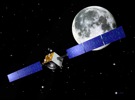SMART-1 - PSA
SMART-1

The European Space Agency's Science Programme encompasses missions of all scales, including a program allowing for small relatively low-cost missions. These have been given the generic name SMART - 'Small Missions for Advanced Research in Technology'. SMART-1, the first in this programme had the primary objective to test a solar electric propulsion system and other deep-space technologies, while performing scientific observations of the Moon. Data from SMART-1 will help to provide answers to questions about the origin of the Moon and to search for ice in the craters at the Moon's south pole. SMART-1 was launched successfully as an Ariane-5 auxiliary payload on 27 September 2003 and entered lunar orbit on 15 November 2004. The mission ended on 3 September 2006 when the spacecraft, in a planned maneuver, impacted the lunar surface in the Lacus Excellentiae region. The complete SMART-1 science data archive was published in August 2010.
SMART-1 Orbiter Instruments
AMIEAdvanced Moon MicroImaging Experiment
AMIE is an imaging system build upon a tele-objective with a 5.3x5.3 degree field of view and an imaging sensor of 1024x1024 pixels, with filters allowing for multispectral observations. This miniaturised micro-imager will study the Moon's morphology, topography and surface texture. |
D-CIXSDemonstration of a Compact Imaging Spectrometer
D-CIXS is a micro-technology demonstrator of a planetary imaging X-ray spectrometer. The instrument will produce absolute elemental abundance values for the lunar surface. Cruise phase observations include X-ray observations of celestial sources and the Earth. |
SIRSMART-1 Infrared Spectrometer
SIR is a highly compact, grating, near-infrared point spectrometer, covering the wavelength range between 0.9 and 2.4 microns. SIR will analyse the composition of the lunar surface to address questions related to the formation and evolution of the Moon. |
SPEDESpacecraft Potential, Electron and Dust Experiment
SPEDE is a double-probe plasma instrument, measuring variations in spacecraft potential and electron flux, and the variability of the electron density and wave electric fields of natural plasmas. In addition, SPEDE will provide dust impact detection data. |
XSMX-ray Solar Monitor
XSM is a solar X-ray spectrometer that will measure the X-ray spectrum of the sun while D-CIXS is imaging the Moon, acting as a calibration system. XSM will also make its own independent study of solar X-ray variability. |
